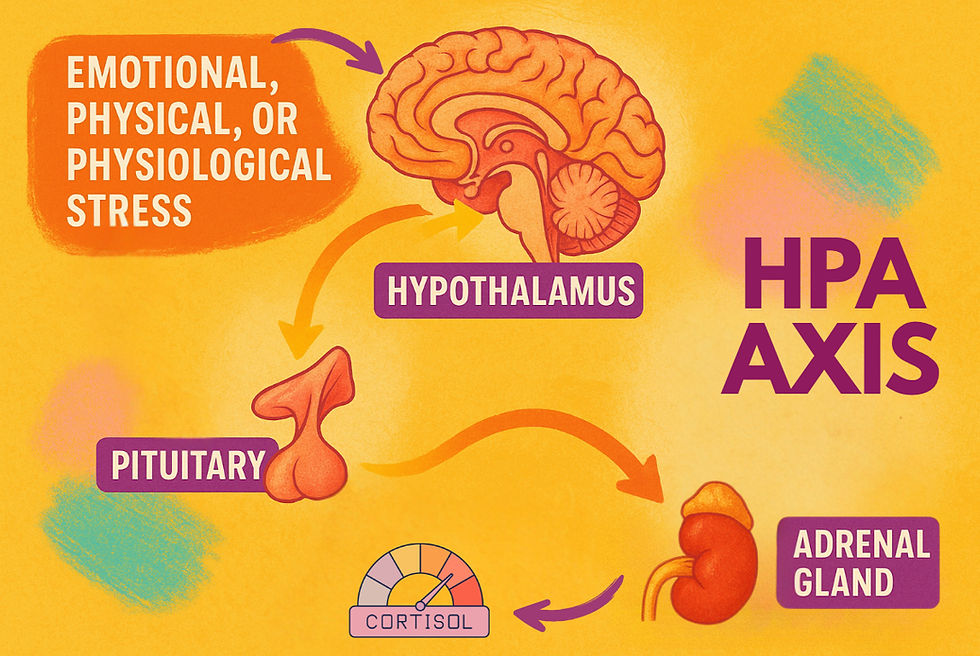Is Your Stress Response System Failing You? Explore HPA-Axis Dysfunction
- Dr. Nazanin Safaei, ND, MS

- Jun 27
- 4 min read

In our fast-paced world, stress is almost unavoidable. But when stress becomes constant, it can lead to serious imbalances in your body’s internal systems—especially the HPA axis, your stress response command center. If you’re always tired, feeling anxious, having trouble sleeping, suffer from hormonal imbalances, or just not bouncing back the way you used to, your HPA axis may be out of sync.
Let’s explor the HPA axis, its functions, the consequences of its dysregulation, and natural ways to restore balance.
What Is the HPA Axis?
The HPA axis stands for Hypothalamic-Pituitary-Adrenal axis. It’s a complex feedback loop between your brain (the hypothalamus and pituitary gland) and your adrenal glands, which sit on top of your kidneys.
This system controls the release of cortisol, your main stress hormone. Cortisol helps regulate:
Blood sugar
Blood pressure
Immune response
Metabolism
Sleep/wake cycles
Mood
Energy levels
Under normal conditions, cortisol follows a daily rhythm: it rises in the morning to help you wake up, then tapers off at night to prepare for rest. But when you’re under chronic stress—whether emotional, physical, physiological, or environmental—this rhythm can get disrupted leading to a range of symptoms.
What Is HPA-Axis Dysfunction?
HPA-axis dysfunction refers to a breakdown in the communication between the brain and adrenal glands. It’s sometimes described as "adrenal fatigue," though this term is not officially recognized in conventional medicine. In naturopathic medicine, it’s better understood as a disruption in cortisol patterns and stress response regulation.
Instead of mounting a healthy response to stress, the body starts producing too much or too little cortisol at the wrong times of the day. This leads to a range of symptoms and health issues.
Common Symptoms of HPA-Axis Dysfunction
HPA-axis dysfunction may show up subtly at first, but symptoms often progress over time if not addressed. Look for:
Morning fatigue or low energy
Trouble falling asleep or waking in the middle of the night.
Feeling “tired but wired”
Frequent illness or slow recovery
Anxiety, mood swings, or irritability
Brain fog or memory issues
Sugar or salt cravings
Weight gain, especially around the belly
Sensitivity to light, noise, or stress
If these symptoms sound familiar, your body may be stuck in stress mode.
How Is HPA-Axis Dysfunction Tested?
While traditional blood tests may not detect subtle dysfunctions, functional or specialty testing can provide deeper insights:
Salivary Cortisol Testing: Measures cortisol at 4–6 points throughout the day to detect abnormal patterns.
Dried Urine Test for Comprehensive Hormones: Evaluates cortisol, cortisol metabolites, and related hormones like DHEA and estrogen.
Serum Cortisol: Useful for identifying extremes (like Addison’s or Cushing’s disease), but may miss nuanced dysfunctions.
Working with a provider who specializes in naturopathic or functional medicine is key for proper interpretation.
How to Support Your HPA Axis Naturally
Restoring balance in the HPA axis requires a holistic approach. Here are some science-backed strategies:
1. Manage Stress Proactively
Practice deep breathing, meditation, or mindfulness daily
Set boundaries with work and technology
Seek therapy or counseling if emotional stress is ongoing
Practice other calming practices on a regular basis
2. Improve Sleep Hygiene
Aim for 7–9 hours of sleep nightly
Keep a consistent bedtime and wake time
Limit screen exposure before bed
3. Eat for Hormone Balance
Prioritize whole foods, protein, and healthy fats
Reduce refined sugar and caffeine
Eat on a regular schedule to stabilize blood sugar
4. When Needed Use Adaptogens and Supplements
Right Adaptogenic herbs can help modulate cortisol
Certain nutrients support adrenal health
Always consult your provider before starting supplements
5. Move Smart
Gentle exercises like walking, stretching, or yoga are beneficial
Avoid overtraining, which can worsen cortisol imbalances
6. Avoid Stimulants
Stop smoking and nicotine use
Limit caffeine and sugar, and alcohol
Conclusion
Your HPA axis is your body’s internal stress regulator—and when it’s out of balance, your entire system can suffer. If you’re feeling chronically fatigued, overwhelmed, or out of sync, HPA-axis dysfunction may be at play. The good news? With proper support and lifestyle changes, your stress response system can be restored to optimal function.
Take the first step by listening to your body, seeking expert guidance, and committing to small, consistent changes that nourish your nervous system and adrenal health.
Disclaimer: The information provided in this article is for informational and educational purposes only and is not intended as medical advice, diagnosis, or treatment. Always consult with a qualified healthcare provider before making changes to your diet, lifestyle, or health care regimen.
References
Chrousos GP. Stress and disorders of the stress system. Nat Rev Endocrinol. 2009;5(7):374–381.
Tsigos C, Chrousos GP. Hypothalamic–pituitary–adrenal axis, neuroendocrine factors and stress. J Psychosom Res. 2002;53(4):865–871.
Panossian A, Wikman G. Effects of adaptogens on the central nervous system and the molecular mechanisms associated with their stress—protective activity. Pharmaceuticals (Basel). 2010;3(1):188–224.
ZRT Laboratory. Adrenal Function and Cortisol Testing. Available at: https://www.zrtlab.com. Accessed June 2025.
Kalmbach DA, Arnedt JT, Song PX, Guille C, Sen S. Sleep disturbance and short sleep as risk factors for depression and perceived medical errors in first-year residents. Sleep. 2017;40(3):zsw073.
©2025 by Nazanin Safaei, ND, MS


